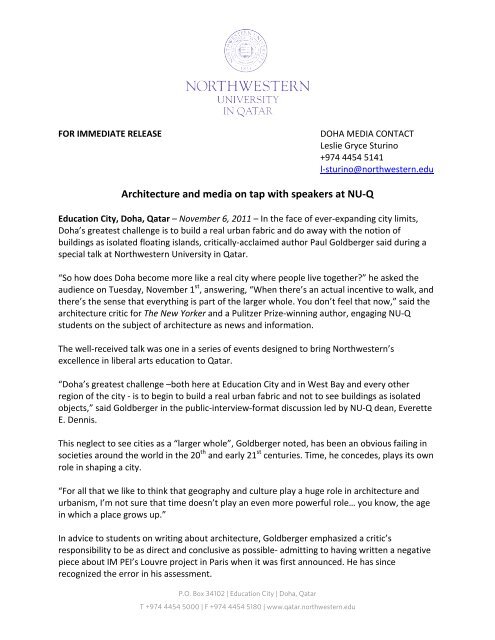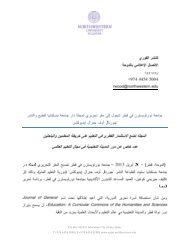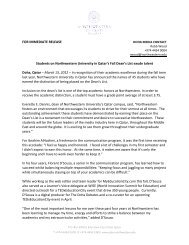P.O. Box 34102 | Education City | Doha, Qatar T - Northwestern ...
P.O. Box 34102 | Education City | Doha, Qatar T - Northwestern ...
P.O. Box 34102 | Education City | Doha, Qatar T - Northwestern ...
You also want an ePaper? Increase the reach of your titles
YUMPU automatically turns print PDFs into web optimized ePapers that Google loves.
FOR IMMEDIATE RELEASE DOHA MEDIA CONTACT<br />
Leslie Gryce Sturino<br />
+974 4454 5141<br />
l-‐sturino@northwestern.edu<br />
Architecture and media on tap with speakers at NU-‐Q<br />
<strong>Education</strong> <strong>City</strong>, <strong>Doha</strong>, <strong>Qatar</strong> – November 6, 2011 – In the face of ever-‐expanding city limits,<br />
<strong>Doha</strong>’s greatest challenge is to build a real urban fabric and do away with the notion of<br />
buildings as isolated floating islands, critically-‐acclaimed author Paul Goldberger said during a<br />
special talk at <strong>Northwestern</strong> University in <strong>Qatar</strong>.<br />
“So how does <strong>Doha</strong> become more like a real city where people live together?” he asked the<br />
audience on Tuesday, November 1 st , answering, “When there’s an actual incentive to walk, and<br />
there’s the sense that everything is part of the larger whole. You don’t feel that now,” said the<br />
architecture critic for The New Yorker and a Pulitzer Prize-‐winning author, engaging NU-‐Q<br />
students on the subject of architecture as news and information.<br />
The well-‐received talk was one in a series of events designed to bring <strong>Northwestern</strong>’s<br />
excellence in liberal arts education to <strong>Qatar</strong>.<br />
“<strong>Doha</strong>’s greatest challenge –both here at <strong>Education</strong> <strong>City</strong> and in West Bay and every other<br />
region of the city -‐ is to begin to build a real urban fabric and not to see buildings as isolated<br />
objects,” said Goldberger in the public-‐interview-‐format discussion led by NU-‐Q dean, Everette<br />
E. Dennis.<br />
This neglect to see cities as a “larger whole”, Goldberger noted, has been an obvious failing in<br />
societies around the world in the 20 th and early 21 st centuries. Time, he concedes, plays its own<br />
role in shaping a city.<br />
“For all that we like to think that geography and culture play a huge role in architecture and<br />
urbanism, I’m not sure that time doesn’t play an even more powerful role… you know, the age<br />
in which a place grows up.”<br />
In advice to students on writing about architecture, Goldberger emphasized a critic’s<br />
responsibility to be as direct and conclusive as possible-‐ admitting to having written a negative<br />
piece about IM PEI’s Louvre project in Paris when it was first announced. He has since<br />
recognized the error in his assessment.<br />
P.O. <strong>Box</strong> <strong>34102</strong> | <strong>Education</strong> <strong>City</strong> | <strong>Doha</strong>, <strong>Qatar</strong><br />
T +974 4454 5000 | F +974 4454 5180 | www.qatar.northwestern.edu
Architecture, he noted, is a powerful setting for one’s personal and work life, and has an<br />
inextricable emotional component.<br />
“So listen to that voice inside of yourself. Your own sensibility is very important,” said<br />
Goldberger.<br />
Goldberger was visiting <strong>Doha</strong> to deliver the opening keynote address at the 4 th biennial Hamad<br />
Bin Khalifa Symposium on Islamic Art held recently at the Museum of Islamic Arts and<br />
sponsored by Virginia Commonwealth University in <strong>Qatar</strong> and others.<br />
Jesús Escobar on parallels between Madrid in its “Golden Century” and <strong>Doha</strong> today<br />
Last week, NU-‐Q also hosted Dr. Jesùs Escobar, chair of <strong>Northwestern</strong> University’s Art History<br />
Department in Evanston, Illinois, who spoke to students on how architecture and politics<br />
interact to shape city design.<br />
In the context of a discussion that asked, “Why study architecture and the city?” the speaker<br />
offered a case study of the European metropolis as a prelude to a discussion that ranged from<br />
architecture as an instrument of power—and how rulers from ancient times to the modern day<br />
have used architecture as a practical and symbolic solution in building nations.<br />
The second speaker in a new lecture and discussion series at <strong>Northwestern</strong> University in <strong>Qatar</strong><br />
called “The Evanston Experience: Great Teachers from <strong>Northwestern</strong> University,” Escobar<br />
lectured on “The Plaza and the Grid: The Design of Cities in the Early Modern Spanish World.<br />
Escobar is chair of <strong>Northwestern</strong> University’s Art History Department in Evanston, Illinois.<br />
“Because we look at Madrid today as a city of 3.5 million people, we think it’s always been a big<br />
city. But it was a very small town in 1561 when it was chosen to become the capital of Spain<br />
and within 40 years it became one of the largest cities of Europe. So the transformation is<br />
phenomenal. And that kind of transformation is one that I think is not too different from what<br />
you are living here,” said Escobar, who has written extensively about Madrid of 16 th and 17 th<br />
centuries, termed Madrid’s “Golden Century.”<br />
-‐-‐ ENDS -‐-‐<br />
About <strong>Northwestern</strong> University in <strong>Qatar</strong><br />
<strong>Northwestern</strong> University in <strong>Qatar</strong>, which started accepting students in 2008, is a partnership of<br />
<strong>Northwestern</strong>’s highly esteemed School of Communication and Medill School of Journalism with the<br />
<strong>Qatar</strong> Foundation for <strong>Education</strong>, Science, and Community Development. At its campus in <strong>Doha</strong>,<br />
<strong>Northwestern</strong> University in <strong>Qatar</strong> offers undergraduate degree programs in communication and<br />
journalism – fields that are rapidly changing, are of enormous social importance, and that offer<br />
P.O. <strong>Box</strong> <strong>34102</strong> | <strong>Education</strong> <strong>City</strong> | <strong>Doha</strong>, <strong>Qatar</strong><br />
T +974 4454 5000 | F +974 4454 5180 | www.qatar.northwestern.edu
abundant and exciting career opportunities. <strong>Northwestern</strong> University is ranked #12 by U.S. News &<br />
World Report. For more information, please visit http://www.qatar.northwestern.edu/.<br />
<strong>Northwestern</strong> University is ranked #12 among all U.S. universities by US News & World Report.<br />
About Paul Goldberger<br />
Paul Goldberger is the Architecture Critic for The New Yorker, where since 1997 he has written the<br />
magazine’s celebrated “Sky Line” column. He also holds the Joseph Urban Chair in Design and<br />
Architecture at The New School in New York <strong>City</strong>. He was formerly Dean of the Parsons school of design,<br />
a division of The New School. He began his career at The New York Times, where in 1984 his architecture<br />
criticism was awarded the Pulitzer Prize for Distinguished Criticism, the highest award in journalism.<br />
He is the author of several books, most recently Why Architecture Matters, published in 2009 by Yale<br />
University Press; Building Up and Tearing Down: Reflections on the Age of Architecture, a collection of<br />
his architecture essays published in 2009 by Monacelli Press, and Christo and Jeanne-‐Claude, published<br />
in 2010 by Taschen. In 2008 Monacelli published Beyond the Dunes: A Portrait of the Hamptons, which<br />
he produced in association with the photographer Jake Rajs. Paul Goldberger’s chronicle of the process<br />
of rebuilding Ground Zero, entitled UP FROM ZERO: Politics, Architecture, and the Rebuilding of New<br />
York, which was published by Random House in the fall of 2004, and brought out in a new, updated<br />
paperback edition in 2005, was named one of The New York Times Notable Books for 2004. Paul<br />
Goldberger has also written The <strong>City</strong> Observed: New York, The Skyscraper, On the Rise: Architecture and<br />
Design in a Post-‐Modern Age, Above New York, and The World Trade Center Remembered.<br />
About Jesús Escobar<br />
Jesús Escobar (Ph.D., 1996, Princeton; Associate Professor) is a specialist in the art, architecture, and<br />
urbanism of early modern Spain, Italy, and the Spanish world. His book The Plaza Mayor and the Shaping<br />
of Baroque Madrid (Cambridge University Press, 2003; paper, 2009) explores the interchange of<br />
architecture and politics in the evolution of Madrid from a secondary city of Castile to the seat of a<br />
global empire. The book won the Eleanor Tufts Award from the American Society for Hispanic Art<br />
Historical Studies and was published in a Spanish-‐language edition in 2008 by Editorial Nerea. Professor<br />
Escobar is currently at work on a book project tentatively titled “Architecture and Empire in<br />
Seventeenth-‐Century Madrid,” which examines buildings and public spaces in early modern Madrid<br />
within the context of developments in architecture, urbanism, and imperial governance in the larger<br />
Spanish world. Other current research projects focus on the historiography of the baroque in Spain and<br />
seventeenth-‐century royal palaces in Madrid, Mexico <strong>City</strong>, and Lima.<br />
Professor Escobar serves as Editor for the scholarly book series, Buildings, Landscapes, and Societies,<br />
published by Penn State University Press and is a member of the Board of Directors of the Society of<br />
P.O. <strong>Box</strong> <strong>34102</strong> | <strong>Education</strong> <strong>City</strong> | <strong>Doha</strong>, <strong>Qatar</strong><br />
T +974 4454 5000 | F +974 4454 5180 | www.qatar.northwestern.edu






